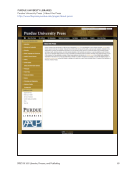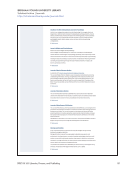13 SPEC Kit 357: Libraries, Presses, and Publishing
practices so that library publishing can best support immediate financial concerns and overall work in
support of the library and institutional missions. This advice is further supported by respondents who
noted the blurred lines between press and library publishing operations, where both existed, and the
different mission opportunities, for example where libraries publish works with intellectual merit even
without a market for commercializing the work.
The survey responses also illuminated the many types of publications being produced in library
publishing, and the vast array of systems in use. One best practice that emerges from the comments is
to use existing digital library and repository systems whenever possible, and then to supplement these
with appropriate additional systems for specific services, for example, Open Journal Systems (OJS) to
complement existing repository and preservation systems, Scalar and Omeka for digital scholarship, and
WordPress for web publishing, which is now a core system in this regard.
The survey data suggests that staffing is at a point of rapid evolution where most institutions have
limited dedicated staff, who are complemented by support and expertise drawn from other staff members.
As noted in the lessons learned responses, libraries expect to increase dedicated staffing to better align
publishing services and supports. Importantly, the majority of libraries are responding to the new roles
and competencies for publishing by expanding the job qualification standards beyond the MLS alone.
In most cases, libraries are developing publishing services under the umbrella of scholarly
communications. Many respondents noted that the reason for library publishing and press activities
include supporting strategic goals and mission in regards to moving forward open access initiatives
and changing models for scholarly communications. Press activities are closely aligned with repository,
digital, and/or open access initiatives and services, which are areas that have the potential for funding
increases to support greater mission alignment for scholarly communications overall.
With library publishing and press activities and programs rapidly developing, including
collaboration with partners and utilization of externally vended services, the survey responses indicate
the need for additional activities in regards to program formalization, outreach to authors, and
assessment. Specific activities of note for outreach include marketing at scholarly society meetings and
assessment closely aligned with author outreach to develop and expand publishing activities.
The landscape for libraries, presses, and publishing remains at a stage of high complexity and
rapid evolution. With the majority of ARL members already engaged in publishing or publishing support
activities, and many having robust and long-standing publishing activities, next phases of growth will be
informed and enhanced through collaboration with institutional presses, scholarly advisory boards, other
libraries, and related communities. The survey findings also suggest a need for greater engagement with
the community of practice, through collaboration with ARL and with groups like the Library Publishing
Coalition and Association of American University Presses.
Endnotes
1 “Home,” Library Publishing Coalition, https://librarypublishing.org/.
2 In 2014, 20 AAUP presses reported to their institutional libraries (see: Charlotte Roh, “Library-Press
Collaborations: A Study Taken on Behalf of the University of Arizona,” Journal of Librarianship and
Scholarly Communication 2, no. 4, https://jlsc-pub.org/articles/abstract/10.7710/2162-3309.1102/).
The 2015–2016 AAUP annual report found that, of the 81 institutions that were both ARL and AAUP
members, at 21 of those institutions, the press reports to the library.
practices so that library publishing can best support immediate financial concerns and overall work in
support of the library and institutional missions. This advice is further supported by respondents who
noted the blurred lines between press and library publishing operations, where both existed, and the
different mission opportunities, for example where libraries publish works with intellectual merit even
without a market for commercializing the work.
The survey responses also illuminated the many types of publications being produced in library
publishing, and the vast array of systems in use. One best practice that emerges from the comments is
to use existing digital library and repository systems whenever possible, and then to supplement these
with appropriate additional systems for specific services, for example, Open Journal Systems (OJS) to
complement existing repository and preservation systems, Scalar and Omeka for digital scholarship, and
WordPress for web publishing, which is now a core system in this regard.
The survey data suggests that staffing is at a point of rapid evolution where most institutions have
limited dedicated staff, who are complemented by support and expertise drawn from other staff members.
As noted in the lessons learned responses, libraries expect to increase dedicated staffing to better align
publishing services and supports. Importantly, the majority of libraries are responding to the new roles
and competencies for publishing by expanding the job qualification standards beyond the MLS alone.
In most cases, libraries are developing publishing services under the umbrella of scholarly
communications. Many respondents noted that the reason for library publishing and press activities
include supporting strategic goals and mission in regards to moving forward open access initiatives
and changing models for scholarly communications. Press activities are closely aligned with repository,
digital, and/or open access initiatives and services, which are areas that have the potential for funding
increases to support greater mission alignment for scholarly communications overall.
With library publishing and press activities and programs rapidly developing, including
collaboration with partners and utilization of externally vended services, the survey responses indicate
the need for additional activities in regards to program formalization, outreach to authors, and
assessment. Specific activities of note for outreach include marketing at scholarly society meetings and
assessment closely aligned with author outreach to develop and expand publishing activities.
The landscape for libraries, presses, and publishing remains at a stage of high complexity and
rapid evolution. With the majority of ARL members already engaged in publishing or publishing support
activities, and many having robust and long-standing publishing activities, next phases of growth will be
informed and enhanced through collaboration with institutional presses, scholarly advisory boards, other
libraries, and related communities. The survey findings also suggest a need for greater engagement with
the community of practice, through collaboration with ARL and with groups like the Library Publishing
Coalition and Association of American University Presses.
Endnotes
1 “Home,” Library Publishing Coalition, https://librarypublishing.org/.
2 In 2014, 20 AAUP presses reported to their institutional libraries (see: Charlotte Roh, “Library-Press
Collaborations: A Study Taken on Behalf of the University of Arizona,” Journal of Librarianship and
Scholarly Communication 2, no. 4, https://jlsc-pub.org/articles/abstract/10.7710/2162-3309.1102/).
The 2015–2016 AAUP annual report found that, of the 81 institutions that were both ARL and AAUP
members, at 21 of those institutions, the press reports to the library.



















































































































































































